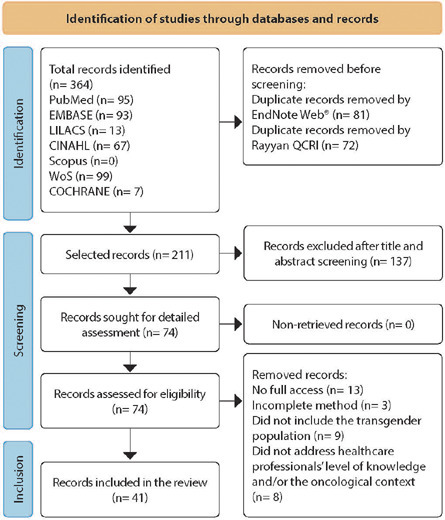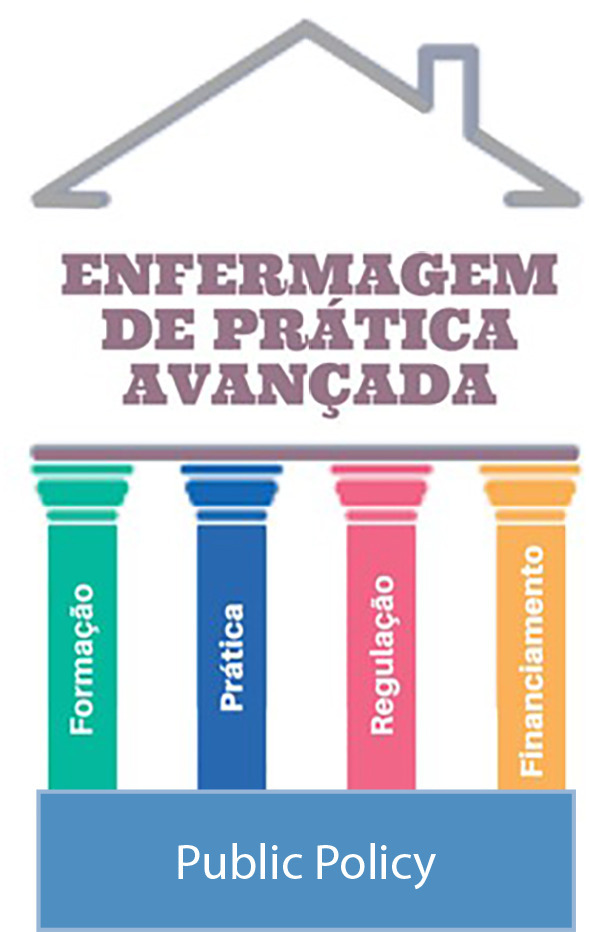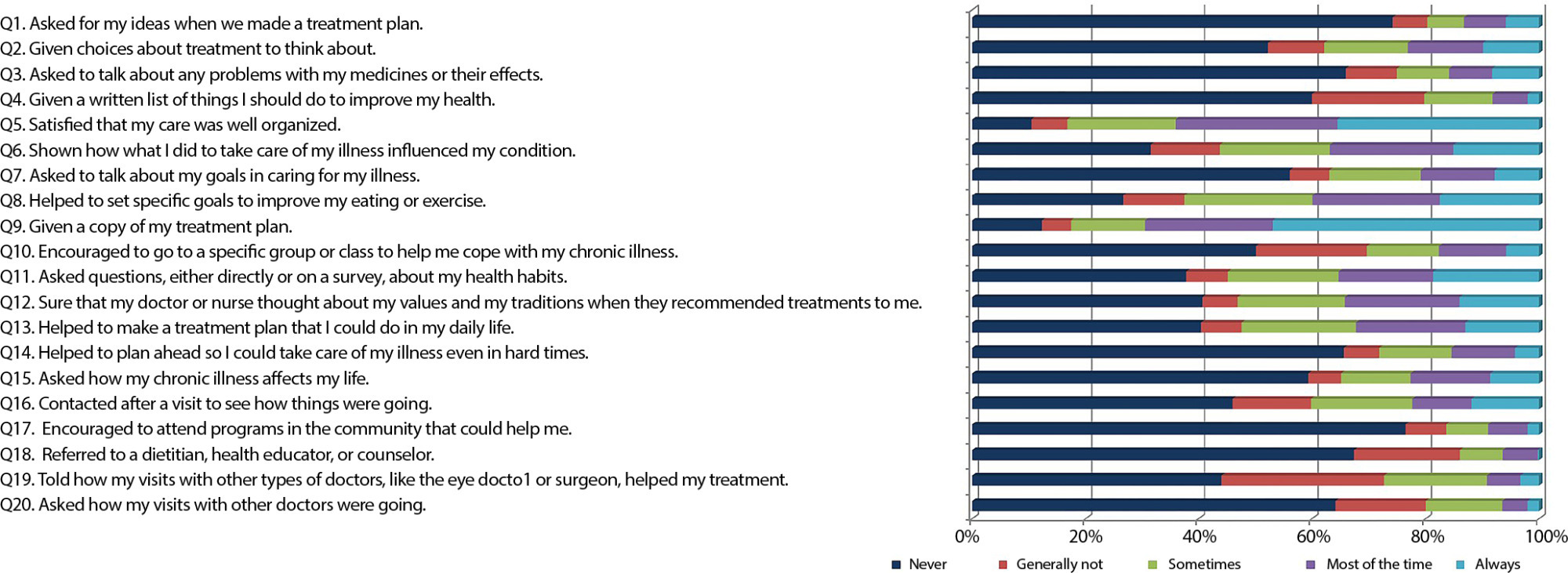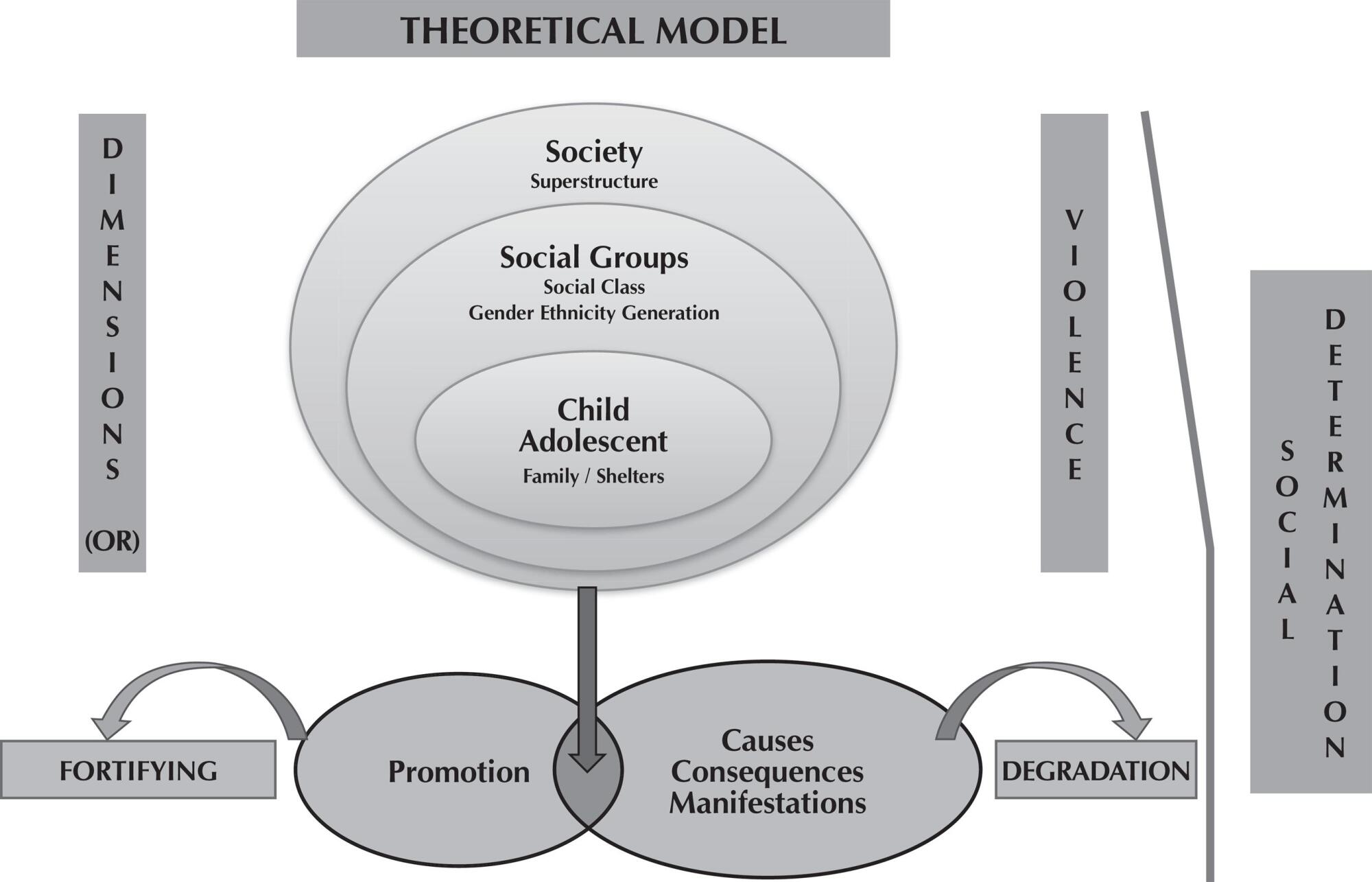-
ORIGINAL ARTICLE12-13-2024
Nurses’ experience regarding patient safety in mobile pre-hospital care
Revista Brasileira de Enfermagem. 2024;77(5):e20230529
Abstract
ORIGINAL ARTICLENurses’ experience regarding patient safety in mobile pre-hospital care
Revista Brasileira de Enfermagem. 2024;77(5):e20230529
DOI 10.1590/0034-7167-2023-0529
Views0See moreABSTRACT
Objectives:
to understand nurses’ experience regarding patient safety in mobile pre-hospital care.
Method:
a qualitative, exploratory and descriptive study, conducted with nurses active in mobile pre-hospital care services. Semi-structured interviews were conducted, audio-graved and submitted to Bardin’s content analysis.
Results:
from four thematic categories established, nurses reported the care and management skills necessary to work in this service. They demonstrated a commitment to ensuring safe care for patients, staff and spectators. They highlighted the actions taken to prevent and mitigate incidents. However, they based their experiences on practice protocols and individual actions, expressing the need to improve knowledge about patient safety.
Final Considerations:
mobile pre-hospital care nurses’ experience in relation to patient safety was limited, suggesting the need for training on the subject, alignment of work processes and implementation of strategies, aiming to guarantee safe care.
-
ORIGINAL ARTICLE12-13-2024
Repercussions of the pandemic on tuberculosis control actions from the perspective of health professionals
Revista Brasileira de Enfermagem. 2024;77(5):e20230477
Abstract
ORIGINAL ARTICLERepercussions of the pandemic on tuberculosis control actions from the perspective of health professionals
Revista Brasileira de Enfermagem. 2024;77(5):e20230477
DOI 10.1590/0034-7167-2023-0477
Views0See moreABSTRACT
Objectives:
to analyze the repercussions of the COVID-19 pandemic on tuberculosis control actions from the perspective of primary health care professionals.
Methods:
this descriptive study with a qualitative approach was conducted from November 2022 to April 2023, using semi-structured interviews with 11 key informant professionals from primary health care units in a Brazilian capital. Data were organized using Atlas.ti 22.0 software and subjected to thematic-categorical content analysis.
Results:
the pandemic scenario caused alterations in the work process, necessitating abrupt adaptations, and led to detrimental impacts on the health of professionals and tuberculosis control actions, which were reduced or discontinued.
Final Considerations:
there was evident unpreparedness and a lack of resources from various governmental levels and health services to handle the public health emergency situation without severe harm to the provision of essential services.
-
Training of Brazilian indigenous nurses: between human rights, valuing diversity and inclusion
Revista Brasileira de Enfermagem. 2024;77(5):e20230430
Abstract
Training of Brazilian indigenous nurses: between human rights, valuing diversity and inclusion
Revista Brasileira de Enfermagem. 2024;77(5):e20230430
DOI 10.1590/0034-7167-2023-0430
Views0See moreABSTRACT
Objectives:
to analyze the possibilities and potential of training indigenous nurses, given the Brazilian Health System (SUS), understanding the relationships between education and health.
Methods:
theoretical-reflective study, based on scientific literature, aligned with the experience, critical thinking of its authors and the Sustainable Development Goals in Brazil.
Results:
this text articulates three axes: Potential for including indigenous students in nursing training; Paths to achieving equity through inclusion and retention policies for indigenous students at different levels; and Implications of this for the SUS and global health.
Final Considerations:
indigenous students, beneficiaries of affirmative actions, face challenges of inclusion and retention in public universities that directly impact their academic training. Added to this are the difficulties identified in basic education, professor training and implementation of permanence policies, with consequences for services and training at other levels.
-
ORIGINAL ARTICLE12-13-2024
Interobserver agreement in Reception and Risk Stratification in Obstetrics implementation
Revista Brasileira de Enfermagem. 2024;77(5):e20230361
Abstract
ORIGINAL ARTICLEInterobserver agreement in Reception and Risk Stratification in Obstetrics implementation
Revista Brasileira de Enfermagem. 2024;77(5):e20230361
DOI 10.1590/0034-7167-2023-0361
Views0See moreABSTRACT
Objectives:
to analyze interobserver agreement in the Reception and Risk Stratification in Obstetrics protocol implementation.
Methods:
a cross-sectional study carried out during Reception and Risk Stratification in Obstetrics implementation, conducted in a tertiary hospital in southern Brazil with 891 participants in January 2020. Descriptive and interobserver agreement analysis was carried out using the Kappa coefficient in the risk stratification assigned by the triage nurse and reviewed by the researcher.
Results:
around half of the calls (55.6%) were stratified as not very urgent (green), followed by urgent (yellow) (31.8%), very urgent (orange) (9.3%), not urgent (blue) (3.4%) and no emerging stratification (red). Agreement analysis of revised stratification found Kappa values of 0.20 (blue), 0.54 (green), 0.77 (yellow) and 0.80 (orange).
Conclusions:
most appointments were non-urgent. The agreement analysis between the revised and assigned risk stratification revealed greater interobserver agreement as the priority level increased.
-
ORIGINAL ARTICLE12-13-2024
Adaptation and implementation of a Nursing care protocol for children in the Amazon Region
Revista Brasileira de Enfermagem. 2024;77(5):e20230245
Abstract
ORIGINAL ARTICLEAdaptation and implementation of a Nursing care protocol for children in the Amazon Region
Revista Brasileira de Enfermagem. 2024;77(5):e20230245
DOI 10.1590/0034-7167-2023-0245
Views0See moreABSTRACT
Objectives:
to describe the process of implementing an adapted protocol for pediatric nursing care in a health unit located in a municipality in the Amazon Region.
Methods:
methodological research conducted in a basic health unit with four family health teams in the state of Rondônia, involving seven nursing professionals. Data collection occurred between October 2020 and April 2022, following the research phases: situational diagnosis, exploratory phase, protocol definition, implementation, and evaluation.
Results:
the outcome was the adaptation and implementation of a nursing care protocol for children.
Final Considerations:
the adaptation and implementation process can be an effective approach to improving care, strengthening nursing as a profession with a solid foundation in scientific and clinical evidence. This facilitates early problem identification and appropriate guidance, leading to better health outcomes for children.
-
ORIGINAL ARTICLE12-13-2024
Nurses’ experiences in caring for people with mental health problems hospitalized due to clinical comorbidities
Revista Brasileira de Enfermagem. 2024;77(5):e20230136
Abstract
ORIGINAL ARTICLENurses’ experiences in caring for people with mental health problems hospitalized due to clinical comorbidities
Revista Brasileira de Enfermagem. 2024;77(5):e20230136
DOI 10.1590/0034-7167-2023-0136
Views0See moreABSTRACT
Objectives:
to understand nurses’ experiences in caring for people with mental health problems hospitalized due to clinical comorbidities in non-psychiatric Inpatient Units.
Methods:
qualitative study, guided by Alfred Schutz’s social phenomenology. Sixteen phenomenological interviews were conducted. The content was analyzed and discussed based on the literature, through the composition of three categories of analysis.
Results:
three categories emerged in the study: Challenges in care faced by nurses; Fragmented care action; and Ideal care. The disarticulation of the clinic was revealed, as described by nurses, showing care as an action far removed from the comprehensiveness of a person. Nurses’ performance is guided predominantly by biomedical reference, disregarding appreciation of subjectivity.
Final Considerations:
it was observed that nurses attribute the responsibility for patient care to factors external to their life-world, when, in fact, these aspects should be components that help them in comprehensive care construction.
-
REVIEW11-29-2024
Assessment of knowledge in oncology about care for transgender people: a scoping review
Revista Brasileira de Enfermagem. 2024;77:e20230532
Abstract
REVIEWAssessment of knowledge in oncology about care for transgender people: a scoping review
Revista Brasileira de Enfermagem. 2024;77:e20230532
DOI 10.1590/0034-7167-2023-0532
Views0ABSTRACT
Objective:
to identify evidence available in the literature on instruments and methodologies used to assess healthcare professionals’ knowledge about cancer care for the transgender population.
Methods:
a scoping review was conducted in seven databases, including studies that answered the question: what is the healthcare professionals’ level of knowledge about cancer care for the transgender population?
Results:
forty-one articles were selected that dealt specifically with healthcare professionals’knowledge in relation to care for the LGBTQIAPN+ population, especially the transgender population. Eighteen studies assessed patients’ perceptions of professionals’knowledge, whereas other studies used their own assessment tools, considering the global context of LGBTQIAPN+ health.
Conclusions:
there is no tested and validated instrument that assesses the knowledge about the transgender population’s oncological health, highlighting the need to construct and validate an instrument focused on this population’s needs.
Keywords:Health Services for Transgender PeopleNeoplasmsOncologyProfessional TrainingTransgender PeopleSee more
-
ORIGINAL ARTICLE10-06-2023
Nursing students’ professional values for reinforcing the professional identity
Revista Brasileira de Enfermagem. 2023;76:e20220338
Abstract
ORIGINAL ARTICLENursing students’ professional values for reinforcing the professional identity
Revista Brasileira de Enfermagem. 2023;76:e20220338
DOI 10.1590/0034-7167-2022-0338
Views0ABSTRACT
Objectives:
to understand the nursing students’ professional values in different Brazilian universities and verify a correlation between the “Professional Value” and the sociodemographic variables.
Methods:
quantitative, cross-sectional, and descriptive study conducted through an electronic questionnaire with a Professional Values Scale (NPVS-3). Participants were Nursing students of all semesters from three universities – two in the Southeast region and one in the North region.
Results:
of the 337 participating Nursing students, 282 were female. The Caring dimension presented the highest score (mean=46.61), and Professionalism, the lowest score (mean=34.65). A statistically significant association was detected between the Caring dimension, “university where is attending,” and “gender.”
Conclusions:
the results indicate the Caring dimension as the one containing the most scored professional values since the nurses’ training, and the relation of those values in such dimension is more significant in the female sample.
Keywords:Code of EthicsKnowledge ManagementNursing EthicsNursing StudentsRole of the Nursing ProfessionalSee more -
EDITORIAL10-06-2023
Pesquisa Translacional em Saúde: para onde vamos?
Revista Brasileira de Enfermagem. 2023;76(5):e760501
Abstract
EDITORIALPesquisa Translacional em Saúde: para onde vamos?
Revista Brasileira de Enfermagem. 2023;76(5):e760501
DOI 10.1590/0034-7167.2023760501pt
Views0Os contributos das pesquisas científicas são incontestáveis para o avanço da ciência e para a sociedade. Por isso, cada vez mais reflexões acerca dos impactos e da aplicabilidade dos estudos têm permeado o centro das discussões em nível global, sobretudo diante do aumento crescente da produção de conhecimentos. Nesse cenário, a translação da pesquisa (TP) […]See more -
EDITORIAL10-06-2023
Translational Health Research: where are we going?
Revista Brasileira de Enfermagem. 2023;76(5):e760501
Abstract
EDITORIALTranslational Health Research: where are we going?
Revista Brasileira de Enfermagem. 2023;76(5):e760501
DOI 10.1590/0034-7167.2023760501
Views0The contributions of scientific research are undeniable for the advancement of science and for society. Therefore, more and more reflections on the impacts and applicability of studies have permeated the center of discussions at a global level, especially considering the growing increase in knowledge production. In this scenario, research translation (RT) has a notable importance […]See more -
Advanced Practice Nursing: “Training” Pillar in Supporting the Proposal in Brazil
Revista Brasileira de Enfermagem. 2023;76(5):e20230118
Abstract
Advanced Practice Nursing: “Training” Pillar in Supporting the Proposal in Brazil
Revista Brasileira de Enfermagem. 2023;76(5):e20230118
DOI 10.1590/0034-7167-2023-0118
Views0ABSTRACT
Objectives:
to present the pillars that support what has been called Advanced Practice Nursing and discuss the necessary training for its implementation.
Methods:
elements contained in assessment documents for graduate programs proposals, reports of presentations by international professors in countries and selected scientific publications were gathered to compose the argument.
Results:
practice/competency (adds broad and in-depth knowledge about health processes and scientific evidence, clinical reasoning and clinical skills for therapeutic indications); 3) professional regulation (corresponding legislation and monitoring); and 4) funding (broad training and professional practice policy).
Final Considerations:
the agenda for implementing Advanced Practice Nursing in Brazil involves joining efforts to identify stakeholders for a work to legitimize their importance in the country’s health and education overview.
Keywords:Advanced Practice NursingEducationGraduateHealth Postgraduate ProgramsNursingNursing EducationPublic PolicySee more
-
ORIGINAL ARTICLE10-06-2023
Quality of health care in Primary Care: perspective of people with Diabetes Mellitus
Revista Brasileira de Enfermagem. 2023;76(5):e20230008
Abstract
ORIGINAL ARTICLEQuality of health care in Primary Care: perspective of people with Diabetes Mellitus
Revista Brasileira de Enfermagem. 2023;76(5):e20230008
DOI 10.1590/0034-7167-2023-0008
Views0See moreABSTRACT
Objectives:
to identify how people with diabetes assess the care offered by Primary Care teams.
Methods:
a cross-sectional study based on structured interviews with the application of the Patient Assessment of Chronic Illness instrument to people with Type 2 Diabetes Mellitus. Data were submitted to statistical analysis.
Results:
451 individuals participated in the study, more than half aged 60 years or older (64.0%); 63.9% had been diagnosed for more than five years; and 23.9% used insulin. The average score obtained was 2.5, which indicated little involvement in self-care and low support for the care of the chronic condition by the Family Health Strategy team, and was higher among women and people with a partner.
Conclusions:
people with diabetes consider that they do not receive individualized treatment, with dialogue and discussion for setting goals, and that they are not prepared for self-managing their health condition.

-
REVIEW10-06-2023
Nursing theories in the care of stroke patients: a scoping review
Revista Brasileira de Enfermagem. 2023;76(5):e20220791
Abstract
REVIEWNursing theories in the care of stroke patients: a scoping review
Revista Brasileira de Enfermagem. 2023;76(5):e20220791
DOI 10.1590/0034-7167-2022-0791
Views0See moreABSTRACT
Objectives:
to map and synthesize nursing theories and conceptual frameworks that have been applied in the practice of nursing care for stroke patients in hospital settings.
Methods:
a scoping review was conducted in October 2022 using the MEDLINE (accessed via PubMed), CINAHL, Scielo, and Web of Science databases, following The Joanna Briggs Institute guidelines.
Results:
nine studies incorporated six nursing theories and three conceptual frameworks, which were employed to enhance stroke patient care. The objective of these theories and conceptual frameworks was to facilitate the identification of the patient’s psychobiological, psychosocial, and psychospiritual needs, elucidate the nurse’s role and expand their perspective on rehabilitation, and acknowledge the survivor’s process of transition.
Final Considerations:
this mapping exercise identified major nursing theories, middle-range theories, and conceptual frameworks applied to the care of stroke patients.

-
ORIGINAL ARTICLE10-06-2023
Learning strategies of undergraduate nursing students during the COVID-19 pandemic
Revista Brasileira de Enfermagem. 2023;76(5):e20220764
Abstract
ORIGINAL ARTICLELearning strategies of undergraduate nursing students during the COVID-19 pandemic
Revista Brasileira de Enfermagem. 2023;76(5):e20220764
DOI 10.1590/0034-7167-2022-0764
Views0See moreABSTRACT
Objectives:
to analyze the learning strategies used by nursing students from a public university, in remote teaching, during the COVID-19 pandemic.
Methods:
a cross-sectional study developed with nursing students who attended remote teaching classes. The sample was obtained by convenience and data were collected online, with 112 participants. Student and Mann-Whitney tests were performed for data analysis.
Results:
the most frequently used learning strategies were self-regulatory and cognitive. There was moderate use of interpersonal help-seeking and emotional control strategies. Male students, with a private study environment and good internet connection, used emotional control strategies more frequently.
Conclusions:
self-regulatory and cognitive learning strategies, appropriate for higher education, were frequently used by nursing students, which is an important tool for adapting these students to the university context.
-
ORIGINAL ARTICLE10-06-2023
Nursing, history, and orthopedics in manuals (1875-1928)
Revista Brasileira de Enfermagem. 2023;76(5):e20220567
Abstract
ORIGINAL ARTICLENursing, history, and orthopedics in manuals (1875-1928)
Revista Brasileira de Enfermagem. 2023;76(5):e20220567
DOI 10.1590/0034-7167-2022-0567
Views0See moreABSTRACT
Objectives:
to discuss the content of manuals, with emphasis on orthopedics, in support of the development of nursing care culture.
Methods:
cultural-historical method articulated with document analysis technique. The sources were nursing manuals – Portuguese, French, English, and Spanish – from 1875 to 1928.
Results:
this study pointed to 12 works – 6 authored by physicians, 2 by nurses, 3 institutional, and 1 by a Sister of Charity – that presented, in a transversal way, the professionalization process initiated in Europe. The manuals addressed first aid care and immobilization methods, from the simplest, such as improvised splints, to the application of plaster casts.
Conclusions:
the nurses’ work, even in a limited capacity, showed that they were able to observe warning signs so that doctors could act, with some exceptions.

-
RESEARCH06-01-2015
Workers of CEASA: factors associated with fatigue and work ability
Revista Brasileira de Enfermagem. 2015;68(3):460-466
Abstract
RESEARCHWorkers of CEASA: factors associated with fatigue and work ability
Revista Brasileira de Enfermagem. 2015;68(3):460-466
DOI 10.1590/0034-7167.2015680312i
Views0See moreABSTRACT
Objective:
to investigate the socio-demographic characteristics, lifestyle and health conditions related to fatigue and the work ability.
Method:
a cross-sectional study was conducted in 2011 and the sample was composed by 90 workers from the supply center of Campinas. Three questionnaires were used: Fatigue; Work ability index; and socio-demographic characteristics.
Results:
in the univariate regression analysis, the variables associated with work ability were: education, use of medicine, stress, pain in the last six months and pain in the last week. In univariate regression analysis the variables associated with fatigue were: education, stress, sleepiness, pain in the last six months, pain in the last week and health problems.
Conclusion:
these results indicate the need for health promotion program implementation among these workers.
-
RESEARCH06-01-2015
Nursing Terminology defines domestic violence against children and adolescents
Revista Brasileira de Enfermagem. 2015;68(3):452-459
Abstract
RESEARCHNursing Terminology defines domestic violence against children and adolescents
Revista Brasileira de Enfermagem. 2015;68(3):452-459
DOI 10.1590/0034-7167.2015680311i
Views0See moreABSTRACT
Objective:
Identifi cation of terminology relating to nursing practices aimed at children and adolescents at risk of domestic violence.
Methods:
bibliographic descriptive research which selected 40 articles from the Virtual Health Library on domestic violence against children and adolescents, its manifestations, causes, and consequences, in association with nursing procedures for its confrontation and prevention, and which also identifi ed terminology via computer tools.
Results:
17,365 terms that, after standardization and uniformity procedures, resulted in a listing of 915 terms.
Conclusion:
The terminology selected focused on the individual biopsychic nexus and the historic manifestation of this phenomenon was partially identifi ed in terms that appear less frequently in these articles, thereby explaining the contradiction between the formal identifi cation logic of such terminology and the dialectic logic that recognizes the historic reasons for, and dynamicity of, such phenomena.

-
RESEARCH06-01-2015
Instrumento para avaliação de estilo de vida sedentário em pacientes com hipertensão
Revista Brasileira de Enfermagem. 2015;68(3):445-451
Abstract
RESEARCHInstrumento para avaliação de estilo de vida sedentário em pacientes com hipertensão
Revista Brasileira de Enfermagem. 2015;68(3):445-451
DOI 10.1590/0034-7167.2015680310i
Views0See moreRESUMEN
Objetivo:
este artículo describe la precisión diagnóstica del International Physical Activity Questionnaire en la identifi cación del diagnóstico enfermero Estilo de vida sedentario.
Método:
un estudio de precisión diagnóstica se desarrolló con 240 individuos con hipertensión arterial establecida. El análisis de precisión diagnóstica se basó en medidas de sensibilidad, especifi cidad, valores predictivos, razones de verosimilitud, efi ciencia, odds ratio diagnóstica, índice de Youden y área bajo la curva característica receptor-operador.
Resultados:
diferencias estadísticas entre los sexos se observaron para las actividades intensidad moderada y la actividad física total. La edad se correlacionó negativamente con la actividad de intensidad moderada y la actividad física total.
Conclusión:
el análisis del área bajo la curva característica receptor-operador para las actividades de intensidad moderada, de caminar, y la actividad física total mostró que el International Physical Activity Questionnaire presenta moderada capacidad para clasificar correctamente los sujetos con y sin el estilo de vida sedentario.
-
RESEARCH06-01-2015
Instrument for evaluation of sedentary lifestyle in patients with high blood pressure
Revista Brasileira de Enfermagem. 2015;68(3):445-451
Abstract
RESEARCHInstrument for evaluation of sedentary lifestyle in patients with high blood pressure
Revista Brasileira de Enfermagem. 2015;68(3):445-451
DOI 10.1590/0034-7167.2015680310i
Views0See moreABSTRACT
Objective:
this article describes the diagnostic accuracy of the International Physical Activity Questionnaire to identify the nursing diagnosis of sedentary lifestyle.
Method:
a diagnostic accuracy study was developed with 240 individuals with established high blood pressure. The analysis of diagnostic accuracy was based on measures of sensitivity, specifi city, predictive values, likelihood ratios, effi ciency, diagnostic odds ratio, Youden index, and area under the receiver-operating characteristic curve.
Results:
statistical differences between genders were observed for activities of moderate intensity and for total physical activity. Age was negatively correlated with activities of moderate intensity and total physical activity.
Conclusion:
the analysis of area under the receiver-operating characteristic curve for moderate intensity activities, walking, and total physical activity showed that the International Physical Activity Questionnaire present moderate capacity to correctly classify individuals with and without sedentary lifestyle.
-
RESEARCH06-01-2015
Potentialities and weaknesses in the care network of people with HIV/AIDS
Revista Brasileira de Enfermagem. 2015;68(3):438-444
Abstract
RESEARCHPotentialities and weaknesses in the care network of people with HIV/AIDS
Revista Brasileira de Enfermagem. 2015;68(3):438-444
DOI 10.1590/0034-7167.2015680309i
Views0See moreABSTRACT
Objective:
to understand the strengths and weaknesses in the care network of people with HIV/AIDS in a referral center in the state of Santa Catarina-SC.
Method:
participants were eight subjects and their care network, totaling 18 participants. Data were collected through interviews and examined by content analysis, theoretically supported by symbolic interaction.
Results:
the analysis resulted in the following categories: The network offering care to people with acquired immunodefi ciency syndrome, and Facing Barriers in care, which refl ect the strengths and weaknesses in the care network. The fi rst depicts the provision of emotional and humanized care, and the second a restricted network formed by health professionals and a family member.
Conclusion:
the professional care network is important, despite the increased number of assistances in a physical structure and amount of professionals who no longer meet the growing demand.
-
RESEARCH06-01-2015
AIDS epidemic in the triple frontier: subsidies for professional practice
Revista Brasileira de Enfermagem. 2015;68(3):429-437
Abstract
RESEARCHAIDS epidemic in the triple frontier: subsidies for professional practice
Revista Brasileira de Enfermagem. 2015;68(3):429-437
DOI 10.1590/0034-7167.2015680308i
Views0See moreABSTRACT
Objective:
to analyze the AIDS epidemic trend from 1988 to 2012, in a tri-border area.
Method:
Ecological time-series study with data from the Department of informatics from the Brazilian Unifi ed Health System (SUS).
Results:
A total of 1427 cases of AIDS were registered, and 82.1% were aged 20-49 years and 56% in males. The relationship man/woman went from 9/1 to 1/1 and increased the number of cases among individuals with more years of education, also, people aged more than 50 years old the age group from 20 to 34 years old. The most common exposure category was heterosexual, significantly higher among women; on the other hand, drug injection use was associated with male gender.
Conclusion:
seeking to embrace the changes in the epidemiological scenario of AIDS, nursing professionals should implement intervention strategies for people identified as the most vulnerable to HIV infection.
-
RESEARCH06-01-2015
The Informal Caregiver Burden Assessment Questionnaire: validation for Brazil
Revista Brasileira de Enfermagem. 2015;68(3):421-428
Abstract
RESEARCHThe Informal Caregiver Burden Assessment Questionnaire: validation for Brazil
Revista Brasileira de Enfermagem. 2015;68(3):421-428
DOI 10.1590/0034-7167.2015680307i
Views0See moreABSTRACT
Objectives:
to analyze the dimensionality, convergent construct validity and internal consistency of the Informal Caregiver Burden Assessment Questionnaire (QASCI) after its semantic adaptation to Brazil.
Method:
this methodological study was developed with 132 informal caregivers of elders who are dependent of help for basic or instrumental activities of daily living, in a capital city in Northeast Brazil. Quality of life measures related to health, anxiety and depression were used in the analysis of the convergent construct validity of the QASCI.
Results:
the results of the instrument construct validation evidenced statistically signifi cant correlations with the three measures. The confi rmatory factor analysis evidenced good adjustment of the theoretical model of seven factors (domains) of the version used in the group studied. Cronbach’s alpha for the scale total was 0.92.
Conclusion:
the Brazilian version of the QASCI was considered to be valid and reliable for assessing the burden of informal elder caregivers.
-
RESEARCH06-01-2015
Study of billing audits in a teaching hospital
Revista Brasileira de Enfermagem. 2015;68(3):414-420
Abstract
RESEARCHStudy of billing audits in a teaching hospital
Revista Brasileira de Enfermagem. 2015;68(3):414-420
DOI 10.1590/0034-7167.2015680306i
Views0See moreABSTRACT
Objectives:
to determine which component items of hospital bills, examined by nurse auditors, were adjusted the most during pre-analysis; to identify the impact upon revenue caused by the adjustments to bills analyzed by physician and nurse auditors; and to identify disallowances related to items checked by the audit team.
Method:
quantitative, exploratory, descriptive, singlecase study.
Results:
after analysis of 2,613 bills, it was found that the item most included by nurses was gas (90.5%) and the most excluded was inpatient drugs (41.2%). Hemodynamics materials, gases and equipment had the greatest impact on upward adjustments. Downward adjustments were the result of improper entries on bills and did not generate revenue losses. Of total disallowances, 52.24% were related to the pre-analysis of nurses and 47.76% to that of physicians.
Conclusion:
this study of the pre-analysis process provides input that enhances knowledge about hospital bill audits.
Search
Search in:
Nuvem de Tags
Aged (144) Atenção Primária à Saúde (239) COVID-19 (104) Cuidados de Enfermagem (269) Educação em Enfermagem (151) Educação em Saúde (139) Enfermagem (930) Estudos de Validação (131) Health Education (144) Idoso (208) Mental Health (149) Nursing (987) Nursing Care (306) Patient Safety (151) Primary Health Care (284) Qualidade de Vida (104) Quality of Life (106) Saúde Mental (145) Segurança do Paciente (150) Validation Studies (108)



